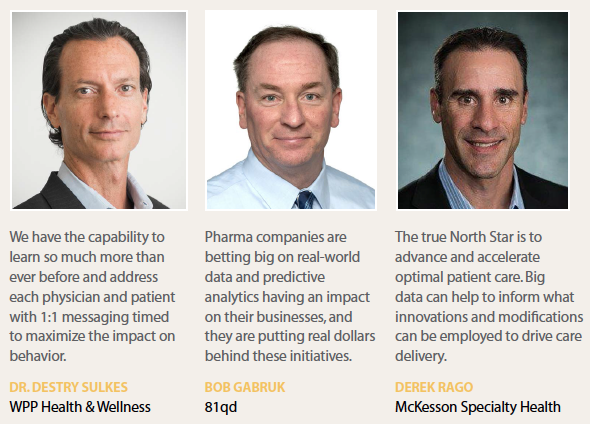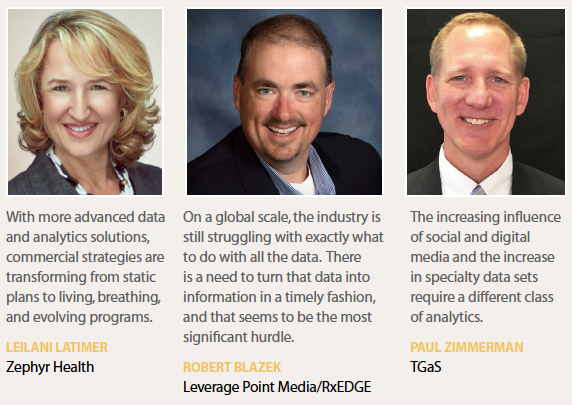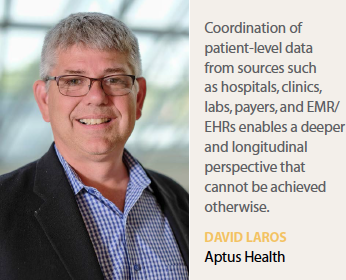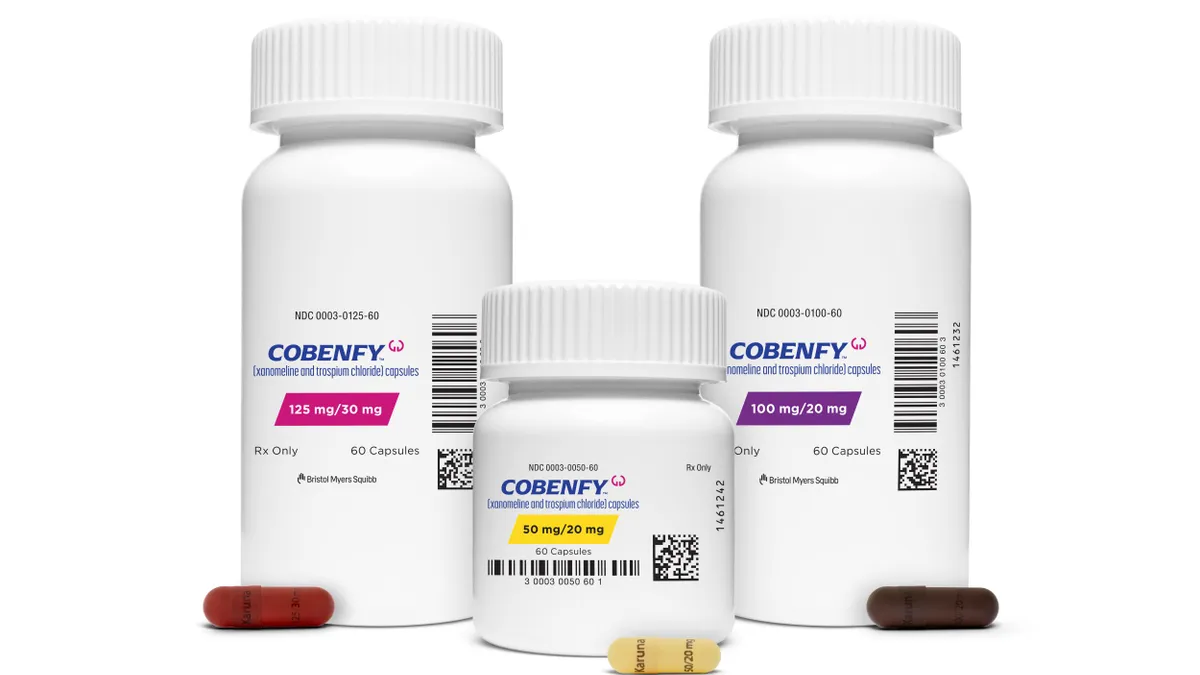Data analytics are crucial tools for pharma marketers, allowing them to harness the power of both traditional and real-world data. Using data analytics through the commercial life cycle can bring valuable insights to bear that enable better targeting and understanding of today’s consumers.
Within the pharmaceutical industry, marketing and sales functions are using data analytics most often and have been for more than a decade. In today’s big data environment, however, there are even more ways for pharma companies to use analytics in marketing and sales. For example, companies are able to pinpoint patient demographics and physician behavior through real-world data sets.
 Big data sets can provide insights to inform high-level strategy and enable pharmaceutical marketers to achieve their commercial objectives, says Robert Lien, associate partner at Beghou Consulting, and there are many types of big data sets that hold valuable insights for pharma marketers. Mr. Lien outlines three types: the first is patient data, which can help a manufacturer’s patient-support team analyze its workload and determine case statuses. The data can inform field access teams as they work with patient-support programs, specialty pharmacies, and medical offices to help with patient access and reimbursement.
Big data sets can provide insights to inform high-level strategy and enable pharmaceutical marketers to achieve their commercial objectives, says Robert Lien, associate partner at Beghou Consulting, and there are many types of big data sets that hold valuable insights for pharma marketers. Mr. Lien outlines three types: the first is patient data, which can help a manufacturer’s patient-support team analyze its workload and determine case statuses. The data can inform field access teams as they work with patient-support programs, specialty pharmacies, and medical offices to help with patient access and reimbursement.
Second are transaction-level claims, such as prescription, medical, and hospital data, which help companies understand patient journeys, including the order of specialists seen, diagnosis, therapies, and tests. These insights help targeting efforts and serve as inputs for forecasting. And third, affiliations data allow companies to draw insights from metrics available at both the physician- and account-levels.
Marketers have had access to data sets for years, which have fueled traditional applications, including market sizing, patient journey analysis, pricing strategies, customer segmentations, and marketing mix.
“Today, the robustness of and access to big data sets is spurring ever more creative analytic applications," says Bob Gabruk, managing director, 81qd. “Marketers have used big data sets — particularly real-world data, such as claims data — for many years across a multitude of applications. The more traditional ones include market sizing, patient journey analysis, pricing strategy, customer segmentation, and marketing mix, among others. New areas such as patient finding for hard-to-diagnose diseases and influence-based marketing to improve effectiveness are gaining success."
 “In addition to the more strategic applications, such as patient finding and influencer marketing, marketers can use predictive models downstream in execution. Many biopharmaceutical companies are experimenting with what some call dynamic call planning, trigger programs, or next-best action. In a nutshell, alerts are sent to reps or nonpersonal messaging is triggered based on models that indicate when a physician has a high probability of having patients eligible for a certain treatment."
“In addition to the more strategic applications, such as patient finding and influencer marketing, marketers can use predictive models downstream in execution. Many biopharmaceutical companies are experimenting with what some call dynamic call planning, trigger programs, or next-best action. In a nutshell, alerts are sent to reps or nonpersonal messaging is triggered based on models that indicate when a physician has a high probability of having patients eligible for a certain treatment."
Before marketers can use the power of big data sets, however, they need to focus on gaining access to the data that is most relevant to their strategy.
“The best way to apply the power of big data sets in commercial strategies is to prioritize having access to the data in the first place," says Paul Zimmerman, director, commercial analytics and insights, TGaS Advisors. “After that is established, companies can more accurately assess current gaps and opportunities using integrated big data sets."
To that end, pharmaceutical companies are focusing resources, both people and budgets, on data management. It is increasingly common to place the chief data officer role in the commercial organization rather than in IT, Mr. Zimmerman says. These roles are tasked with either enhancing, or in some cases establishing, enterprisewide data strategies to address the myriad of available data sets.
The quality of insights that can be gained from the data available today is a big opportunity for commercial strategies, says Destry Sulkes, M.D., chief data officer, WPP Health & Wellness.
“In the past, marketers used epidemiology data to gauge overall market size by geography, and then conducted focus group research with HCPs and patients to learn which canned messages resonated," Dr. Sulkes says. “Today, we have practice-level data to guide personalized insights, and not just patient types and treatment patterns, but deeper human insights around emotional motivators and behavioral economics. We have the capability to learn so much more than ever before and address each physician and patient with 1:1 messaging timed to maximize the impact on behavior."
Data-driven opportunities stretch across the entire product lifecycle from pre- to post-commercialization, says Derek Rago, VP and general manager, business intelligence and product strategy, McKesson Specialty Health.
 Marketers can analyze rich data sets to inform strategies and identify the appropriate patients or prescribers to align to those strategies. For example, the ability to integrate real-time notifications in the patient record at key points in the treatment workflow saves significant time and money over conventional methods.
Marketers can analyze rich data sets to inform strategies and identify the appropriate patients or prescribers to align to those strategies. For example, the ability to integrate real-time notifications in the patient record at key points in the treatment workflow saves significant time and money over conventional methods.
Marketers need timely, relevant data that they can use and act upon now. Data that lag for several months are simply not good enough to keep marketing teams informed about the rapidly evolving specialty marketplace.
“Ultimately, the true North Star is to advance and accelerate optimal patient care," Mr. Rago says. “Big data can help to inform what innovations and modifications can be employed to drive care delivery."
Marketers can search for more granularity in data today. Traditional sources like claims data lack critical details such as biomarkers and some specific diagnosis detail.
Mr. Rago says there is a need to leverage data from electronic health records to accurately characterize the entire treatment pathway, from the time the patient sees a doctor, gets a clinical result, and fills a prescription. For example, marketers want to understand the amount of time between the receipt of critical biomarker results and when a treatment selection was made. They would also want to know if the treatment required prior authorization or was filled using a patient-assistance program.
“Understanding the triggers for interactions in real time helps marketers to target timely outreach and align communications and programs tied to the patient experience," he says. “New data sets and analytics help to demonstrate real-world effectiveness of drugs to allow for improved access."
Big data, and the continuous evolution of availability and application, allow pharmaceutical analysts and systems to move beyond traditional approaches to inform go-to-market strategies, resource allocation, targeting, measurement and optimization, while providing greater insights into stakeholder influences, behaviors, and preferences.
Understanding and analyzing disparate data sets across healthcare provider (HCP), healthcare organization (HCO), and healthcare consumer (HCC) audiences is critical for an improved understanding of the environment, says David Laros, VP of analytics and commercial effectiveness, at Aptus Health.
These data sets should be sourced from syndicated, public, and proprietary sources to better understand profiles, behaviors, attitudes, promotion, interrelationships, and influences.
Coordination of patient-level data from sources such as hospitals, clinics, labs, payers, EMR/EHRs, and more enables  a deeper and longitudinal perspective that cannot be achieved otherwise. The inter-connectivity of data over time for de-identified HCCs can be used to understand, influence, and measure changes across different customer categories through analysis and identification of treatment patterns, adherence, referral patterns, treatment costs, etc. that otherwise would not be possible.
a deeper and longitudinal perspective that cannot be achieved otherwise. The inter-connectivity of data over time for de-identified HCCs can be used to understand, influence, and measure changes across different customer categories through analysis and identification of treatment patterns, adherence, referral patterns, treatment costs, etc. that otherwise would not be possible.
“Through a coordinated and holistic approach, it is possible to gain the best actionable insights that increase awareness, drive engagement, yield improved results, and most importantly generate the desired educational and/or treatment change that supports the overall marketing strategy," Mr. Laros says.
However, the ability to capture the right big data sets, integrate them, and extract insights that can shape the company’s strategic go-to-market is not so simple, says Leilani Latimer, VP global marketing, partnerships and commercial operations, Zephyr Health.
“This is where machine-learning solutions are providing the most value; with AI solutions, larger and more complex sets of data can be connected and analyzed more rapidly," she says. “This gives marketers the ability to segment and sub-segment customers based upon a more sophisticated set of characteristics, and to engage them with timely and tailored messaging — all in support of their commercial strategies."
Marketers and sales teams now have analytics at their fingertips to see how campaigns or sales plans are performing and can adjust them on the fly. “With more advanced data and analytics solutions, commercial strategies are transforming from static plans to living, breathing, and evolving programs," Ms. Latimer says.
Rob Blazek, senior VP, networks and analytics, Leverage Point Media/RxEDGE, says marketers must be able to identify what data are relevant and use the information effectively. Due to the tremendous volume of available data, it is easy to become overwhelmed and not see the forest for the trees. “Many marketers are having a hard time sorting it out and figuring out what the information actually means to their strategy," he says. “We see a lot of companies get bogged down at this point in the process."
Marketers have always wanted to know and still want to know how well their programs are performing, and today their focus has shifted a bit due to the availability of data.
“Over the past six to nine months we’ve seen more marketers interested in looking at two things: first, how well did an individual tactic work, and second how did that tactic fit in the overall marketing mix. They also want to determine how each tactic relates to one another and which tactic may have helped drive the performance of another," Mr. Blazek says.
Marketers are using softer metrics as opposed to impact metrics, which show a direct correlation between the message and an action.
“A lot of money is being spent on TV, and yet it’s difficult to draw a straight line between a television commercial and the impact the ad has on the consumer who fills a prescription," Mr. Blazek adds. “Absolute impact metrics measure the direct influence the messaging had on prescription sales in a test versus control manner. I think the industry is still searching for the right balance between soft metrics and the ultimate hard metric of sales and what it all means."
Data Analytics Trends
In a report from Decision Resources Group, Principal Analyst Matt Arnold notes that one of the new trends in data analytics is coupling real-world evidence data, such as claims and EHR data with traditional market research, and adding social data, search analytics, and clickstream analysis. According to the report, this strategy brings more in-depth and multidimensional views of the customer across his or her decision-making journey, enabling brands to offer the customer or patient the right content and services at the right time and in the right place.
Traditionally, marketing and sales analytics focused on profiling, segmentation, promotional response, resource allocation, and the like. These traditional approaches remain critical components, but today, effective pharma marketing demands much more, Mr. Laros says.
A significant application of this trend is the ability to understand, predict, and apply customers’ — as in healthcare professionals, healthcare consumers, and healthcare organizations — propensity to engage and respond to various promotional stimuli and messaging.
The increasing influence of social and digital media and the increase in specialty data sets require a different class of analytics, and pharmaceutical companies are looking outside of their traditional vendors and partnering with companies that are successful in advanced and prescriptive analytics in other industries. According to Mr.
Zimmerman, this includes leveraging avenues such as machine learning and artificial intelligence (AI).
Mr. Gabruk also notes that the industry is starting to tap into the power of AI and predictive analytics to leverage real-world, patient-level data. 81qd, a data analytics company, is focused on difficult-to-diagnose conditions and has designed a patient-finding solution that enables marketers to help clinicians improve patient outcomes through earlier diagnosis and management. Through machine learning technology, the solution helps identify patients with a high probability of having a specific rare disease so that they can ultimately be screened, clinically diagnosed, and receive the appropriate care.
“AI can be used to identify specific physician practices where undiagnosed patients with the highest probability of having a difficult-to-diagnose condition are currently being managed for other conditions," Mr. Gabruk says. “AI is also used to identify true clinical influencers — those individuals who impact the care of patients exponentially beyond their own practice through their clinical networks."
“These insights can be leveraged to execute influence-based marketing initiatives and optimize medical science liaison and salesforce efficiency," he says. “Maximizing engagements with the most valuable clinicians, as measured through the lens of clinical influence, results in a significantly higher return on investment."
McKesson Specialty Health has identified four key trends in marketing analytics and has observed that all these trends are converging in the oncology space in particular. (See the sidebar for more on the four trends.)
“Oncology is a complex specialty with many therapies for increasingly specific patient populations," Mr. Rago from McKesson Specialty Health says. “It can be hard for physicians to keep up with these scientific advances. Therefore, it’s important that biopharma companies get the right information and education to the right providers. By leveraging data-enabled microtargeting to identify the specific subset of patients within a broader disease state, marketers can deliver timely education to physicians in a less obtrusive way."
Another trend is using social data sets to track patient and physician opinions — called sentiment analytics — via reviews and survey responses, online and social media, and healthcare materials for applications that range from marketing to customer service to clinical medicine. According to Mr. Lien at Beghou Consulting, pharmaceutical companies increasingly track and analyze public sentiment of their brand and therapies on digital public forums and social media. “By enabling a company to pinpoint frequently mentioned words associated with the brand and identify product adoption challenges, sentiment analysis is especially useful during a launch," he says.
Data analytics can be used to provide messaging that resonates with consumers at the time they are open to receive such information. For example, how applications such as Google, Facebook, and Amazon send new product recommendations is based on prior activity. This same experience can be replicated in a pharma brand, marketing, and sales environment, Ms. Latimer says.
“Analytics are becoming more predictive, programmatic, and intuitive for pharmaceutical companies, and it’s now possible to deliver alerts and next-best actions seamlessly," she says. “Solutions that anticipate market needs and operationalize important changes, such as a formulary status change, or responses to a nonpersonal promotion campaign, let sales and marketing teams act on real-time alerts and recommendations. Not only does this change marketing behavior from pull to push, it makes pharma marketers more dynamic in their go-to-market planning and execution."
Data Analytics Cause Strategy Shift
Often advanced data analytics can be used to compare and contrast areas where patients experience different outcomes with the same treatment regimen.
“This allows marketers to optimize engagement and education tactics that drive better ROI," Mr. Rago adds.
As one example of the power of data and analytics, McKesson collaborated with a biopharma company that had a therapy where most patients would discontinue treatment after a few months, an outcome that differed from the clinical trial results for that drug. At the same time, a subset of patients performed better than others with extended time on the therapy. The goal of the collaboration was to identify the subset of patients with extended response relative to the rest of the population to help education physicians on the best patients for their therapy. Leveraging the EHR dataset, McKesson created a prospective registry to monitor the population over time. McKesson was able to identify the reasons behind the differential outcomes and drive targeted education to physicians on the optimal patient population for this therapy.
Information like this is very valuable in selecting what type of messaging is delivered, Dr. Sulkes says. For example, by using data analytics, it is relatively easy to identify a correlation between a patient who is likely to be a diabetic, based on lifestyle factors similar to other patients with diabetes, and the severity of disease, based on frequency of pharmacy purchase histories, foods consumed, activity levels.
“Diabetes patients with a less severe form of the condition respond more to healthy lifestyle recommendations, whereas patients who have a more severe form of diabetes respond more to treatments that can help prevent bad outcomes in the future," he says.
Customers react best when they are understood regarding their preferences, says Mr. Laros.
“It’s exciting to see how our industry is shifting and becoming more open and able to leverage actionable insights that lead to increased awareness, engagement, education, and the desired behavior change among key audiences," he says.(PV)
~~~~~~~~~~~~~~~~~~~~~~~~~
Four Key Data Analytic Trends
Patient-Centric Approach: Just like medicine, marketing strategies are becoming more personalized. Biopharma companies want to educate and empower patients with the information relevant to each stage of their journey. The guiding principle is that every patient matters. Therefore, understanding each patient’s unique journey using deep, reliable data sources like EHRs helps marketers target specific messages to the right patient and provider at the right time. Also, technology solutions, such as patient portals and apps, allow patients to document their experiences and communicate more easily with physicians.
Physician Behavioral Targeting: Another trend in data and analytics is the ability to understand physician preferences and patterns in care delivery. These insights enable marketers to establish more effective marketing tactics that are aligned with the physician’s preferred mode of engagement. To accomplish this, a richer and more granular data set is required, typically generated from an electronic health record (EHR).
Optimizing and Employing Point-in-Time Marketing: The third trend is the ability to optimize marketing tactics to deliver the right message to the right care provider at the right time in the patient’s treatment journey. This means leveraging data to identify the optimal points for critical interventions and associated message delivery.
Data Consolidation and Transformation: The fourth trend is consolidating data from different sources to gain a deeper understanding of the marketplace and help triangulate and inform marketing strategies. Data, especially in the specialty drug space, is fragmented and requires companies to leverage multiple sources to gather the insights they need to deploy their market strategies.
Source: McKesson Specialty Health



















